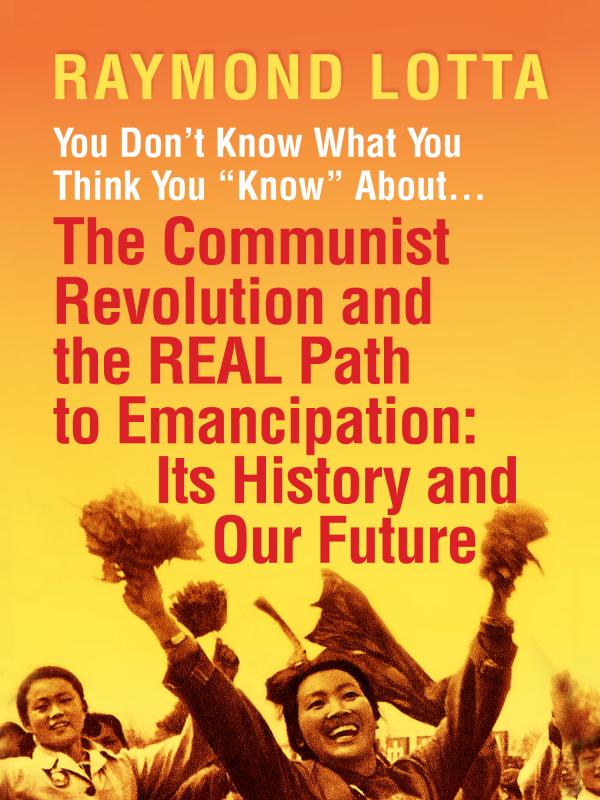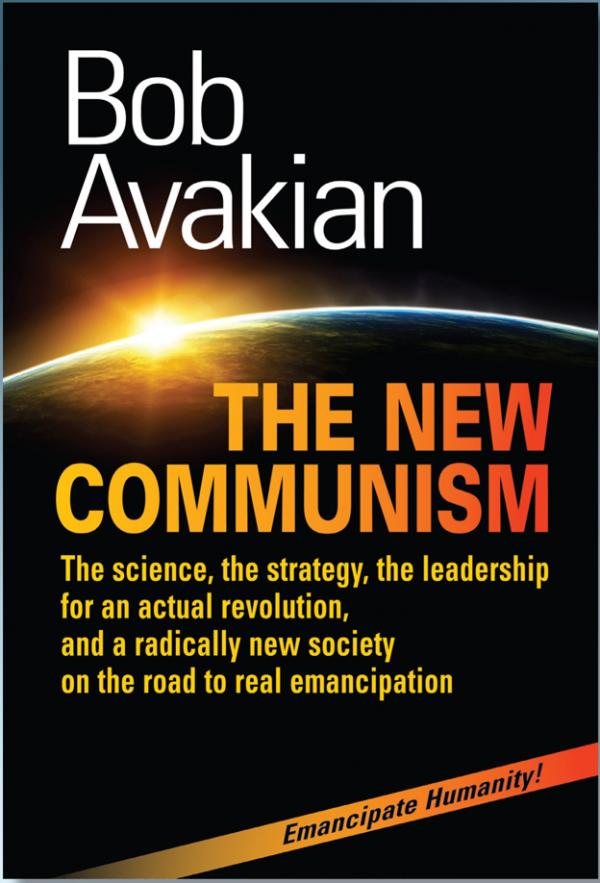Introduction
China was a socialist country between 1949, when the revolutionary forces of millions upon millions led by Mao Zedong overthrew the old exploitative and oppressive order, and 1976—when a new capitalist class carried out a reactionary coup. The Great Leap Forward was a radically transformative economic and social movement in revolutionary China during the years 1958-60. It is also one of the most vilified and distorted episodes in the history of communist revolution. Highly publicized books by anticommunist “experts” in the West have slandered it as a “catastrophe caused by government policies that would kill as many as 45 million” (to quote from a new book by Ian Johnson of the Council on Foreign Relations).
Indeed, it has now become commonplace to describe the Great Leap Forward as “Mao's Great Famine” (the title of an influential book by Frank Dikötter), or as history's “worst man-made famine, ever” (Roderick MacFarquhar). This anti-communist lie is repeated and repeated, recycled and recycled, such that it has become unquestioned (and unquestionable) conventional wisdom.
In fact, the Great Leap Forward was the first bold step by Mao to forge a more liberatory road of socialist economic and social development. At the heart of the Great Leap Forward in China's vast countryside was the movement to form what were called “people's communes.”
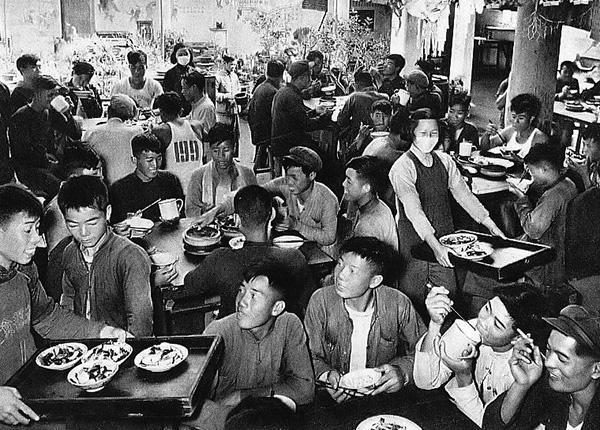
The people's commune collectivized living and working practices during the Great Leap Forward. Here people eat in a communal canteen, 1959.
In what follows, I delineate the real aims and achievements of the Great Leap Forward—as well as the difficulties it encountered and mistakes that were made. I examine the actual causes of the food crisis and famine, and how the revolutionary leadership actually responded. And I explain why the sensationalistic and statistically-inflated death figures are wholly unreliable... and serve an agenda of ruling out communist revolution in today's world.
1) Background to the Great Leap Forward
Before the 1949 revolution, China was a society of brutal landlord rule in the countryside, of rural misery, recurrent famine, years in which peasants ate bark and leaves and sold their children in order to survive. The revolution put an end to this. It carried out a massive land reform, the largest in history, stripping landlords of their wealth and power, distributing land to peasants, allocating parcels per adult, which meant women as well as men!
Soon in the years afterward, peasants, with the backing of the Chinese Communist Party, formed mutual-aid teams to help each other in planting and harvesting. Within a few years of Liberation in 1949, the peasants established cooperatives, in which they farmed land together and distributed the produce according to how much land, tools, and animals each family had put in, as well as their labor.
By the mid-1950s, peasants had formed higher-level cooperatives. They burned the deeds to their land because they now worked the land, tools, and animals in common. This was a zigzag process, with different areas moving at a different pace. Some peasants would join and then drop out. But at some stages of this process, there were waiting lists of peasants wanting to join up. Many peasants pooled their land and labor, giving up isolated plots and working together to change the physical face of the land. This enabled peasants to use tractors and other machinery in areas that had never before even seen an iron plow.
Mao Zedong, the leader of the Communist Party of China, was striving to forge a liberatory road of economic and social development—a road that could rupture with what Bob Avakian has described as “two legacies.”
—The first legacy was the continuing pressure and influence of capitalism and Western imperialism on a society that had been historically dominated and plundered by imperialism.
—The second legacy was the tremendous influence of the developmental model and methods of the Soviet Union. The Soviet approach was marked by a highly technocratic approach to economic development, with a great stress on specialization, a rigid division of labor, reliance on motivating people with income and bonus incentives, and strict top-down enterprise management. And this was linked with a one-sided focus on the development of heavy industry; a steering of resources to the cities and towards the already more highly developed urban sectors.
Mao was developing a model and road of socialist development based on social cooperation and social ownership:
- an economy that would meet the material and social needs of the people
- an economy that would solve China’s historic problem of chronic hunger, malnutrition, and recurrent famine
- an economy that would foster mutually supportive relations between industry and agriculture, instead of soaking up resources from the countryside for industry
- an economy that would contribute to reducing and ultimately overcoming the gaps between city and countryside, between industry and agriculture, and between regions
- an economy that would not rely on material incentives but, rather, rely on conscious activism, and that did not accept widening social differences as “the price of development”
- an economy that relied on and promoted the collective understanding and the collective mastery of the masses over the processes of production
- an economy that could resist imperialist attack and support revolutions in other parts of the world
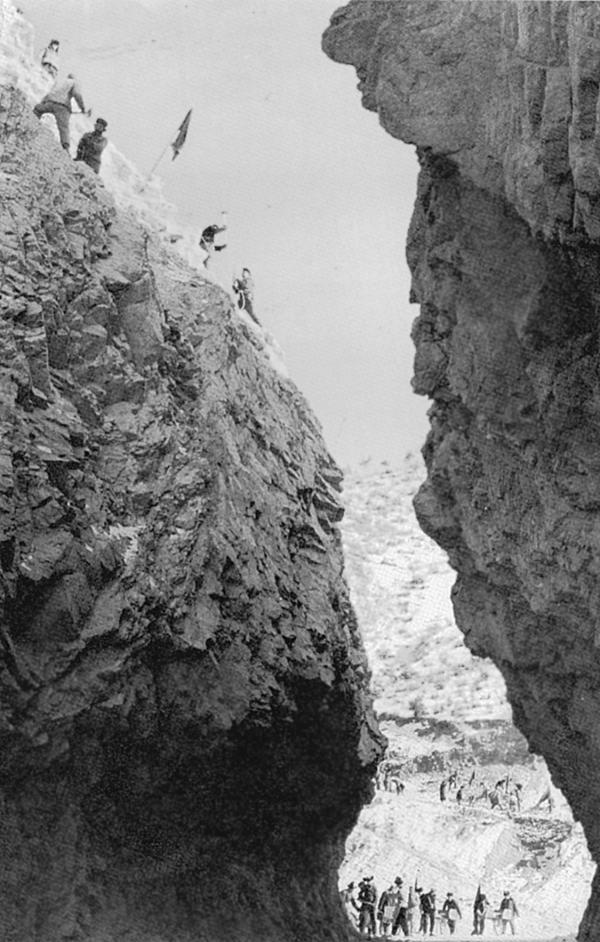
The Red Flag Canal was initiated during the Great Leap Forward with the main channel being completed in 1965. It was dug entirely by hand labour, and provided an irrigation system of 930 miles.
2) The Great Leap Forward Was Quite Rational
I described the historical background and purposes of the Great Leap Forward in a speech, “Socialism Is Much Better than Capitalism, and Communism Will Be a Far Better World”:
The communes started spontaneously. In Henan province in 1957, peasant cooperatives joined forces with their neighbors to begin a vast project to bring water across a mountain range to irrigate dry plains. The peasants merged their cooperatives and created something new: an economic and political form through which tens of thousands of people built a common life. Mao toured these areas and later gave the name “commune” to describe what was going on....
The communes were able to mobilize and organize China’s vast reserve of labor power. Irrigation and flood control works, road construction, reforesting, land reclamation, and other projects could now be planned and carried out on a large scale. Fertilizer and cement factories and small hydroelectric power works were built. The communes provided experimental space for teams of experts and peasants to engage in scientific farming and geological prospecting.
The Great Leap Forward brought women out of the household and into the swirl of the battle to create a new society. The communes opened community dining rooms, nurseries, cooperative home repair, and established other forms of social welfare that provided collective solutions for social needs. Women took part in the start-up of new factories and in irrigation projects like the famous Red Flag Canal. “The Iron Women’s Brigade” was in the front lines of that project.
Old habits and values were questioned. Ideological struggle was waged against superstition, prejudice, and fatalism, along with feudal customs that still persisted, like arranged marriage. The communes established networks of primary and middle schools, as well as health facilities.
The Great Leap Forward put the emphasis on the rural areas in order to gradually close the gap between the city and countryside, and between workers and peasants. Small-scale industries took root in the countryside; peasants began to master technology; scientific knowledge was spread. The approach of the Great Leap was a liberating alternative to the process of rural dislocation and massive urban immigration that takes place in the imperialist-dominated countries.
A self-reliant economy that spread industrial and technical capabilities through the countryside could also stand up better to imperialist attack and invasion and support world revolution.
The Great Leap Forward is often decried as “irrational,” “reckless,” and “utopian.” But there was nothing irrational about collectivizing land holdings to promote mechanization and more social forms of work and cooperation; nothing irrational about creating rural infrastructure like water control projects, or planting forests and orchards, or expanding rural industry in the countryside; and certainly nothing irrational about overcoming inequality between men and women and the age-old domestic responsibilities that have been foisted on women.
But this is certainly “irrational” from the standpoint of the calculus of capitalism-imperialism that imposes a model of export-oriented production on countries of the global South, pressuring and mandating that they shift out of subsistence and basic food production to focus on specialty crops and goods (from cut flowers to asparagus) destined for consumption in the rich capitalist countries—while having to import basic foodstuffs, going into debt, and enabling international investors to grab up land and pushing and pulling vast numbers of impoverished peasants into the cities.
Now there were problems and shortcomings of the Great Leap Forward, as would be expected of a massive movement of transformation on this scale. There were measures and experiments that proved to be impractical. But, again, the defining features and breakthroughs of the Great Leap Forward are dismissed and derided by the ideologues of capitalism and the status quo as “reckless” and “dangerous” not because they were that—but because they formed part of a viable path beyond exploitation, social inequality, and subordination of rural development to the cities.
The most important thing about the Great Leap Forward was not the mobilization of people in creative and cooperative ways for production... or the economic strategy of combining more basic technology with more developed and advanced technologies... or the focus on balanced and self-reliant development in the countryside—monumental as all that was. The most important thing was that relations between people were changing. New relations of ownership embodied in the the system of communes brought people together in new cooperative ways. People were working and living and struggling in new ways, and taking up the study of Marxism to more deeply understand and more consciously change society... and themselves.
The Great Leap Forward was, more than anything else, a leap in mass consciousness and a leap in mass social organization.
Raymond Lotta kicking off the Fall Speaking Tour at Revolution Books NYC, September 19
3) Contradictions and Difficulties of the Great Leap Forward; Food Crisis and Famine
Of all the lies hurled at the Great Leap Forward, none is more poisonous than the claim that the policies of the Great Leap Forward—and Mao’s commitment to the Great Leap Forward—were directly responsible for massive famine. In the work of anti-communist ideologues like Jung Chang and Jon Halliday in Mao: The Unknown Story, Jasper Becker in Hungry Ghosts, and Frank Dikotter in Mao’s Great Famine, wild estimates of “needless” famine deaths are pumped out, with numbers ranging from 18 to 30 to 45 million starvation deaths.
What is the truth? In the years 1959-61, there was a food crisis and famine that led to many deaths. But what was the cause of this, and what was the response of the revolutionary state?
In terms of the immediate cause, there was a steep decline in grain production in 1959, and food availability declined greatly in the next two years. In other words, a food crisis that turned into a famine was principally an issue of supply.
There were multiple reasons for this, but the decisive fact is that starting in 1959 China suffered its worst climatic disasters of the 20th century. By 1960, crop damage caused by floods and drought affected over half of China’s agricultural land. Drought alone affected one-third of the land. Bad weather accounted for a large portion of the grain-yield losses that underlay the massive agricultural crisis of 1959-61. (See Y.Y. Kueh’s important study, based on extensive data and modeling, of China’s weather conditions and their effect on grain output in the period—listed in references at the end of this article.)
A Hostile International Environment
The grain shortage and food crisis were also exacerbated by the international situation. By the late 1950s, state-to-state and party-to-party relations between revolutionary China and the Soviet Union had been rapidly deteriorating. Mao had been critiquing the Soviet leadership as revisionist—analyzing that it had gone off the socialist road and was selling out the interests of the world revolution to imperialism. The Soviets had castigated the Great Leap Forward as reckless and utopian. And they sought out like-minded elements within the Chinese leadership!
As relations between China and the Soviet Union grew more strained in 1960, the Soviet leadership looked to punish and isolate the People’s Republic. In July-August 1960, the Soviet Union withdrew experts, halted aid, and walked off with blueprints to unfinished industrial installations. The Soviets also left China saddled with a large debt burden, most of it incurred during the Korean War of the early 1950s. (China had sent great numbers of fighters, as well as material resources, and suffered great human losses, to aid the struggle of the Korean people against U.S. imperialism.)
Mao and the revolutionary leadership wanted to free the country of external debt dependency to maximize maneuvering room. So China continued to sell grain on the world market to generate earnings to pay back the Soviet debt—and this adversely affected grain/food availability.
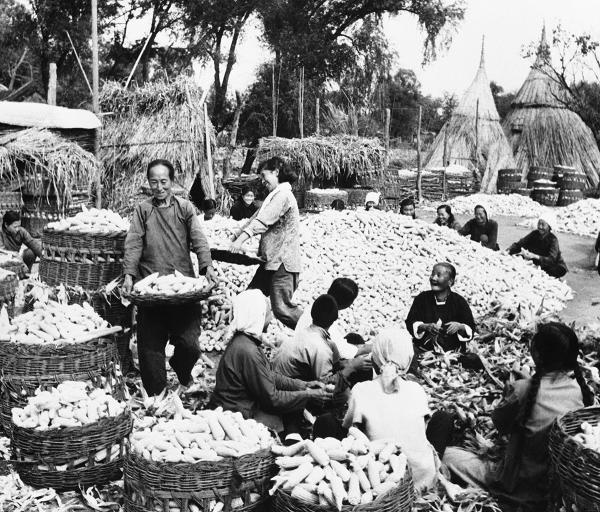
People's commune, developed during Great Leap Forward, working collectively to harvest corn near Peking, China, January 1959. Photo: AP
Additionally, there was intense pressure and threat from U.S. imperialism. In 1958, the pro-U.S. Kuomintang regime in Taiwan and the People’s Republic had military clashes over islands in the Taiwan Strait. The U.S. was backing Taiwan strongly and issuing threats. And, as classified government documents released by Daniel Ellsberg revealed in 2021, the U.S. was actively drawing up plans to carry out nuclear strikes against the People’s Republic of China. Further, in 1959 the CIA had helped incite a reactionary uprising in Tibet (a province of China); and tensions between India and China were growing, with India carrying out armed incursions in 1959.
The point is this: Just 10 years out from achieving liberation and launching socialist revolution in 1949, China faced this hostile international environment. It was not a situation of its own making. China had to develop military and corresponding industrial capacity. Its new central economic planning system had to take account of this international situation. The Great Leap Forward, this bold revolutionary initiative, with all its trials and errors, was unfolding in a particular and extremely difficult international setting.
Policy Mistakes
Natural (climate) factors were the overriding and immediate cause of the grain shortfalls. But policy mistakes made by the Maoists also contributed to the food crisis:
A) The speed with which the communes were formed and the initial tendency to create excessively large communes led to some problems in organizing and managing grain production along with other aspects of the communes—like health, education, militias, common eating halls.
B) In striving to diversify economic activity in many areas, local officials often diverted too much peasant labor into non-agricultural projects. The result was that not enough people were working the fields. Examples of this were steel smelting and other local industry, public construction and irrigation works, and so forth. Most of this was beneficial in the long run towards creating new capabilities and contributing to all-around and balanced growth. In some parts of the country the infrastructure projects were undertaken during what were traditionally slow or idle seasons in the agricultural cycle. But, now, with more peasants being asked to participate in such physically demanding projects, more food calories were needed when less was being produced.
Mao was paying attention and at an important Communist Party meeting in Lushan in 1959 took responsibility for some of the mistakes of overly ambitious planning, including unrealistic expectations of smelting of steel in “backyard furnaces” (especially when there was not the corresponding transport to make optimal use of this steel).
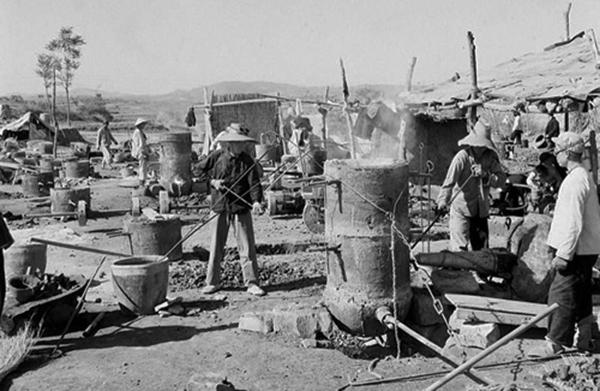
1958 China: people work with backyard furnaces to produce steel during The Great Leap Forward.
C) The state was also requiring too much grain from rural areas relative to local needs. In the socialist economy, the state was both providing support to the countryside and collecting and distributing grain to feed the urban population. But quotas for delivery of grain were set too high. Why? Some of this was due to communication flows in the planning system. A big factor was that the central authorities were receiving inaccurate information from below. Local officials often inflated output levels, leading central authorities to believe that they had tens of millions of metric tons more grain than was actually available.
There was what came to be called “the wind of exaggeration” coming from leadership of many communes and collectives, and from regional leaders, even though they knew what the conditions were. It’s important to consider some of what was driving that.

Misreporting and the Problem of “Official Ideology”
Here I want to touch on the problem of “official ideology.” In revolutionary China, and so too in the Soviet Union when it was socialist (1917-56), communism was viewed, even proclaimed, as the “official ideology” of society. The conception was that, because a socialist society was being created and because it was led by communists, people were expected to agree with, to accept, and profess this ideology. This became what amounted to almost a requirement to fully participate in and take responsibility for society.
Bob Avakian’s criticism of this notion of an “official ideology” is an important part of his summation of the experience of communist revolution, and his development of the new communism. While the philosophy and science of communism must be popularized and occupy a leading position in socialist society—so that the masses can gain the knowledge and method to understand and change the world—people must not be pressured to think in a certain way. People must be won to Marxism, to communism—including through vigorous debate with proponents of different trends of thought. They can’t be forced to profess it in order to fully or meaningfully participate in civil society.
How is this relevant to the Great Leap Forward? A point of orientation of the revolutionary line guiding the Great Leap Forward was the principle of unleashing mass initiative and creativity to achieve what was called “greater, faster, better, more economical results” in production, as part of building the new socialist economy. But the pressure of “official ideology” contributed to a situation where responsible local officials often sought to “prove” their support for the socialist cause, for the cause of the Great Leap Forward, by inflating output levels. At times this became a competition for who could out-report others in achieving “faster, better, more economical results.” Which meant that real difficulties and failures often got covered over.
1958 was in fact a good harvest year, and many local officials unrealistically projected far higher yields in the coming year or two—and reported this way. In some cases, enthusiasm carried the day; in others, local officials wanted to curry favor. All this impaired the accurate flow of information. Again, planning authorities believed, on the basis of information they were getting, that they had more grain to collect and distribute than was the case.
But more fundamentally, you don’t want an atmosphere in socialist society in which people are reluctant to surface problems and disagreements. But this was part of what was going on. Had dissenting voices been given more room and had debate been more actively encouraged, some of the problems might have come to light earlier. This would have incurred risks—and the stakes were very high—given the intense international encirclement and pressure on revolutionary China, along with the internal situation in China that included right-wing opposition to the Great Leap Forward within the Communist Party that I describe in section 4 below. But through the course of such debate, people would have gained greater ability to sort out honest criticism and principled opposition from attempts to actually destroy this historic initiative and restore capitalism.

Now in 1962, Mao gave a talk on democratic centralism (the organizational principle of the Communist Party) in which he pointed out that “without democracy, you have no understanding of what is happening down below; the situation will be unclear; you will be unable to collect sufficient opinions from all sides; there can be no communication between top and bottom; top-level organs will depend on one-sided and incorrect material to decide issues....” This is important. But the weight of “official ideology” not only put constraints on gaining deeper knowledge of the situation; it also limited wider debate and discourse on policy and direction.
Mao’s thinking and practice did develop further. In launching the Cultural Revolution of 1966 to prevent the revolution from being reversed by a new capitalist class headquartered in the Communist Party—a situation in which the Communist Party had become significantly calcified at the same time that too many in society were simply “going along” with things—Mao spoke to this. In a 1967 talk, he explained that he had been searching for a way to “to expose our ‘dark side’ from below,” that is, through mass mobilization and debate to spring society into the air and further revolutionize society.
4) Measures to Cope with the Hunger Crisis in a Complex Political Situation
The ever-multiplying, anti-communist accounts of the Great Leap Forward charge that Mao was indifferent to hardship and suffering—that he was hell-bent on “crackpot schemes” for industrial and agricultural transformation, and stubbornly suppressed reports of difficulties and famine-level deaths. This is a lie.
Investigations were conducted and adjustments were made. The communes were reduced in size, eventually stabilizing at about 15,000 to 25,000 people (from some that were initially double that size). The quotas of grain to be delivered to the state were lowered. Certain non-agricultural projects were scaled back. Many workers who had gone to the cities were called back, so that more labor time could be devoted to food production in the countryside.
Grain was rationed countrywide and emergency grain supplies were sent to regions in distress. In late 1960, China also started importing wheat from Canada. And what is rarely recognized in Western accounts is that advances made in transport capacity by the Chinese revolution from 1949 onward, public policy measures, and the new socialist health care system actually limited the loss of life.
In understanding the course of the Great Leap Forward, it is important to recognize that this economic strategy and social movement took place in the context of sharp class struggle in Chinese society.
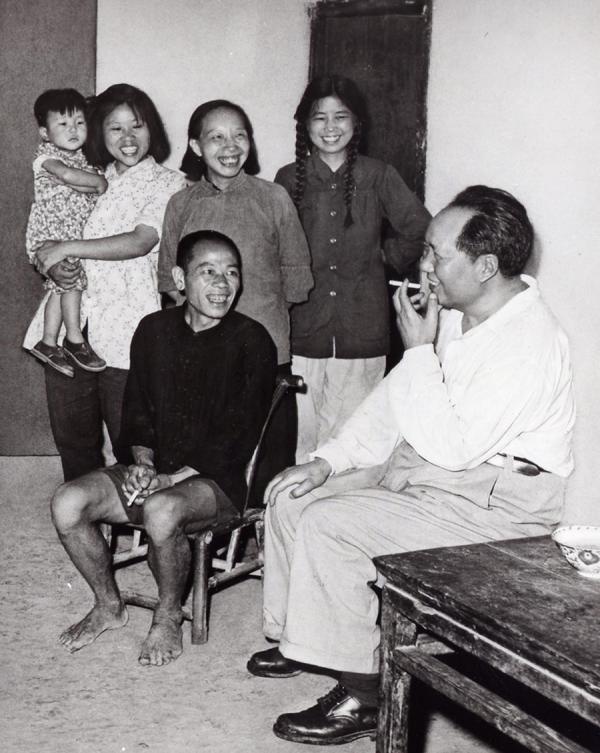
Shaoshan, China, 1959: Mao and peasants talking.
As mentioned earlier, the Soviet model of economic development exerted a great deal of influence—and had its champions at the highest levels of leadership within the Chinese Communist Party. In 1959, at a major leadership conference, the Minister of Defense, Peng Dehuai, launched a fierce political attack on the Great Leap Forward. Peng, who had looked to the Soviet model and to the Soviets as long-term allies and wanted Soviet-style military modernization, rationalized his attack on the Great Leap Forward by posing as the voice of the hungry and suffering. Mao publicized Peng’s memorandum and took on his arguments.
In 1960, in the face of the natural calamities, the growing split between the Soviet Union and China, dislocations and mistakes spoken to, and the terrible food shortages leading to famine—it was urgently necessary to make policy adjustments. But what kind of adjustments was also a matter of class struggle.
The rightist and conservative forces of the Chinese Communist Party were seizing on the crisis to reverse the whole thrust of the Great Leap Forward. They wanted to give play to free market forces in the countryside. They wanted to adopt profit measures to guide investment. They wanted to remove support for small-scale rural industry. Mao and the revolutionaries saw the need to adjust and retreat on various fronts. But they were also fighting to uphold the basic principles and direction of the Great Leap—and carrying the revolution forward to reduce social, urban/rural, and other inequalities.
So, the situation in 1960-61 was not simply one of economic difficulties, famine, and the need for adjustment. There was class struggle concentrated at the highest levels of society—over the road that China would take: socialism or capitalism. And that struggle would come to a head in the Cultural Revolution of 1966-76.
5) Inflating Death Counts to Discredit Mao, Socialism, and Revolution
As for the accusations of 18 million... 30 million... 45 million “senseless” deaths—these are sensationalist and politically motivated estimates. And the extreme range of these numbers (and some go even higher) should itself be a warning sign. In the West, “death counts” of 35-45 million are taken as, and endlessly repeated as, established truth. But these totals are based on unreliable demographic and census data, archival materials of questionable quality, and dubious methodology that makes liberal use of unfounded statistical projections.
For instance, some authors make comparisons between what China’s population would have been, had the population been growing at normal rates without the “excess deaths” of the famine, and population figures of later years. The famine is said to have wiped out the “missing population.”
But as several important studies have shown, birth rates had dropped steeply during the period of the famine. In other words, a portion of the “missing population” simply wasn’t born! And leaving that aside, it is not at all clear that there was anything approaching a comprehensive national death registration system in place during these years of upheaval. Moreover, there was considerable movement of population in the rural areas during the Great Leap Forward, especially as the crisis deepened, which adds another level of difficulty to tracking population changes and death rates.
In addition to the questionable reliability of the raw statistical material on which such charges as 45 million deaths are based, there was also a “political agenda” at work when the new capitalist rulers of China, who had carried out a counterrevolution in 1976 after Mao died, released data in 1983 that seemed to “support” the thesis of a massive famine. This was a time when these new capitalist rulers led by Deng Xiaoping were engaged in a campaign to discredit the Great Leap Forward and the Cultural Revolution, and waged a broad ideological attack on the whole idea of collective-based agriculture (see the study by Joseph Ball in the list of references).
To close this section: A terrible famine did take place in 1959-61. The difficulties of those years, as analyzed here, were a complex phenomenon. More research is called for to advance understanding. But the sordid, shoddy “famine scholarship” that is endlessly promoted and repeated serves an entirely different function. Which is to demonize Mao, to distort the actual aims and purposes of the Great Leap Forward and put on offer “history by inflated body count”—for the purpose of slandering revolution and communism.
Conclusion
To sum up, the Great Leap Forward was guided by coherent policy goals; tapped the energy and enthusiasm of the peasant masses; and yielded enormous positive long-term effects. Indeed, by 1970 China was able, for the first time in its history, to solve its historic food problem. The new society was able to provide for a minimal nutritional diet and food security.
This had everything to do with the Great Leap Forward and the formation of communes. It had everything to do with the collective mobilization of people to build irrigation and flood works, to reclaim and improve land, to master new agricultural techniques, and to establish small industries in the countryside. It had everything to do with the spirit of working for the common good promoted by socialist revolution.
China is no longer a socialist country—capitalism was restored with the defeat of the Cultural Revolution in 1976. Yet the attacks on the Great Leap Forward continue. Why? Within China, there is growing disenchantment with the savageries of China’s capitalism-imperialism: its sweatshop exploitation, environmental devastation, the commodification and degradation of women, and obscene, world-class levels of inequality. These attacks on the Great Leap Forward, as well as the Cultural Revolution, are aimed at frightening people away from revolution.
And that is the role of these attacks internationally. To brainwash people into thinking that revolutions can only lead to nightmare, chaos, and mass death—when in fact revolution in today’s world guided by the new communism developed by Bob Avakian opens the possibility of creating a society and world in which people’s basic material needs can be met, in which oppression can be overcome... and human beings can truly flourish and protect the environment.
That is why my campus speaking tour to crack open the debate about communism’s past and future, and the future of humanity, is so urgent.
Research Resources and Suggested Readings
Historical Background, Aims and Accomplishments of the Great Leap Forward
Bob Avakian, “The Cultural Revolution in China... Art and Culture... Dissent and Ferment... and Carrying Forward the Revolution Toward Communism,” revcom.us, updated May 9, 2016
Wilfred Burchett and Rewi Alley, China: The Quality of Life (New York: Penguin, 1976)
Jean Chesneaux, China: The Peoples’ Republic, 1949-1976 (New York: Pantheon, 1979)
Isabel and David Crook. The First Years of Yangyi Commune (London: Routledge & Kegan Paul, 1979)
Dongping Han, Chapter 2 “Rural Education: Unfulfilled Promises,” and Ch. 3 “Collectivization and Obstacles to Economic Development,” in The Unknown Cultural Revolution: Life and Change in a Chinese Village (New York: Monthly Review Press, 2008)
Han Suyin, Chapter 8 “The Great Leap Forward and the Communes, 1958-1959,” in Wind in the Tower: Mao Tsetung and the Chinese Revolution, 1949-75 (Boston: Little Brown, 1977)
William Hinton, Through a Glass Darkly: U.S. Views of the Chinese Revolution (New York: Monthly Review Press, 2006)
Mao Tsetung. “On the Ten Major Relationships,” April 25, 1956, Selected Works of Mao Tsetung, Vol. 5 (Peking: Foreign Languages Press, 1977) pp. 284-307
Mao Tsetung, “Reading Notes on the Soviet Text ‘Political Economy’ (1961-1962),” in Critique of Soviet Economics (New York: Monthly Review Press, 1977)
Carl Riskin, China’s Political Economy: The Quest for Development Since 1949 (Oxford: Oxford University Press, 1987)
E.L. Wheelwright and Bruce McFarlane, The Chinese Road to Socialism: Economics of the Cultural Revolution (New York: Monthly Review Press, 1971)
The Famine of 1959-61
Joseph Ball, “Did Mao Really Kill Millions in the Great Leap Forward,” Monthly Review, September 2006
Mobo Gao, The Battle for China’s Past: Mao & the Cultural Revolution (London: Pluto Press, 2008)
Dongping Han, “Farmers, Mao, and Discontent in China: From the Great Leap Forward to the Present,” Monthly Review, Vol. 61, Issue 07, December 2009
Y.Y. Kueh, Agricultural Instability in China, 1931-1991: Weather, Technology, and Institutions (New York: Oxford University Press, 1995)
Li Minqi, The Rise of China and the Demise of the Capitalist World Economy (New York: Monthly Review Press, 2008)
Utsa Patnaik, “Republic of Hunger,” in The Republic of Hunger and Other Essays (Pontypool, UK: Merlin Press, 2008)
Daniel Vukovich, Chapter 4: “Accounting for the Great Leap Forward: Missing millions, excess deaths, and a crisis of Chinese proportions,” in China and Orientalism (New York: Routledge, 2011)
